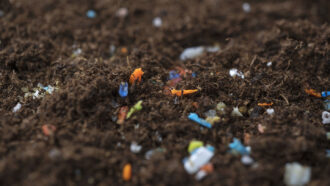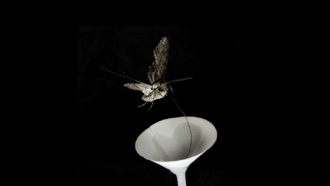Pollution detective
A science fair project tackles contaminated drinking water and mosquito growth.
By Emily Sohn
Kelydra Welcker’s neighbors have an invisible problem.
Kelydra, 17, lives in Parkersburg, W.Va. Nearby, a DuPont chemical plant makes a variety of products, including the nonstick material Teflon. Tiny amounts of an ingredient used to produce Teflon have ended up in the area’s water supply. Lab tests have shown that this chemical, known as APFO, is toxic and may cause cancer in animals.
 |
|
Kelydra Welcker collects a water sample from the Ohio River.
|
| Courtesy of Kelydra Welcker |
The water that comes out of Parkersburg’s faucets looks and tastes fine, but many people worry that drinking it will hurt their health.
Instead of just worrying about the problem, Kelydra took action. She invented a way to detect and help remove APFO from drinking water. And she has applied for a patent on the process.
This science project earned Kelydra a trip to the 2006 Intel International Science and Engineering Fair (ISEF), held last May in Indianapolis. About 1,500 students from around the world competed for prizes at the fair.
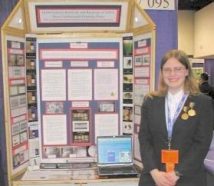 |
|
Kelydra at the Intel International Science and Engineering Fair in Indianapolis.
|
| V. Miller |
“I want to clean the environment,” says Kelydra, a junior at Parkersburg South High School. “I want to make the world a better place for our children.”
Mosquito studies
Kelydra began her research on toxic substances when she was in seventh grade. She wondered how pollution might affect animals in her area’s streams and rivers.
Scientists had already learned that chemicals called steroids can alter fish behavior. As part of her seventh-grade science project, Kelydra looked for similar effects on mosquitoes.
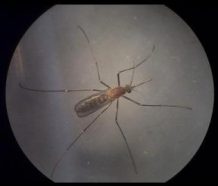 |
|
A female mosquito.
|
| Courtesy of Kelydra Welcker |
She focused on the effects of estrogen and several other steroids that are known as endocrine disruptors. The body’s endocrine system produces chemical substances called hormones. Hormones regulate growth, the production of eggs in females, and other processes essential for life.
As a result of her early research, Kelydra discovered that endocrine disruptors affect the rates at which mosquitoes hatch and that they also change the buzzing sounds that mosquitoes make when they beat their wings. That discovery earned her a spot as a finalist in the 2002 Discovery Channel Young Scientist Challenge (DCYSC).
At DCYSC, Kelydra learned that scientists have to speak clearly if they want to persuade people that their research is significant.
“It’s important to be able to talk in sound bites, short and sweet,” she says, “so that people can put the message in their heads.”
 |
|
Kelydra analyzes the sounds of a mosquito’s beating wings.
|
| Courtesy of Kelydra Welcker |
Another research effort involving mosquitoes brought Kelydra to the 2005 ISEF in Phoenix, Ariz. At this event, she won a $500 prize for the best use of photography in a science project.
Chemical effects
This year, Kelydra focused on APFO, the chemical that has been worrisome to her neighbors in Parkersburg.
APFO is short for ammonium perfluorooctanoate, which is also sometimes called PFOA or C8. Each molecule of APFO consists of 8 carbon atoms, 15 fluorine atoms, 2 oxygen atoms, 3 hydrogen atoms, and 1 nitrogen atom.
APFO is a building block in the production of Teflon. It’s also used in the manufacture of water- and stain-resistant clothing, fire-fighting foams, and other products. And it can form from substances used to make grease-resistant fast-food packaging, candy wrappers, and pizza-box liners.
The chemical has shown up not only in drinking water but also in the bodies of people and animals, including those living in the Parkersburg area.
To illustrate the potential dangers of APFO, Kelydra turned again to mosquitoes. She bred some 2,400 mosquitoes in her kitchen and timed their life cycles.
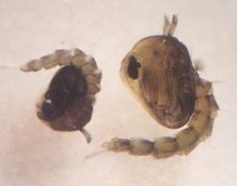 |
|
Mosquito pupae just after hatching.
|
| Courtesy of Kelydra Welcker |
Her results suggested that when APFO is in the environment, mosquitoes hatch sooner than they do normally. So, more generations of mosquitoes end up living and breeding each season. With more mosquitoes around, diseases that they carry, such as West Nile virus, can spread more quickly, Kelydra says.
Water treatment
To help her neighbors and to improve the environment, Kelydra wanted to find a way to detect and measure APFO in water. She sought to create a test that was simple and inexpensive so that people could analyze water coming out of their home taps.
Kelydra knew that when you shake water contaminated with relatively high amounts of APFO, the water gets foamy. The more APFO in the water, the foamier it gets. When APFO gets into drinking water, however, the concentrations are usually too low to create foam.
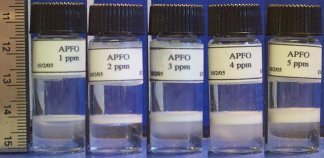 |
|
A higher concentration of APFO in water increases the height of foam created when the sample is shaken.
|
| Courtesy of Kelydra Welcker |
To increase the concentration of APFO in a water sample to levels at which it could be detected by foaming, Kelydra used an apparatus called an electrolytic cell. One of the cell’s electrodes worked like an electrically charged wand. It attracted APFO. This meant that the amount of APFO in the water decreased.
At the same time, she could carefully rinse off the wand, creating a new solution with a higher concentration of APFO. When she shook the new solution, foam formed.
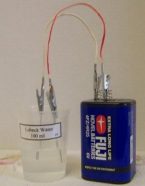 |
|
This apparatus, consisting of a dry cell and two electrodes, allowed Kelydra to remove much of the chemical APFO from contaminated water.
|
|
Courtesy of Kelydra Welcker
|
“It worked like a dream,” Kelydra says.
The technique can do more than detect APFO in water, she says. It might also help people remove the chemical from their water supply.
Next year, Kelydra plans to create a system that will allow people to purify several gallons of water overnight. She’s enthusiastic about the idea. And, on the basis of her experiences so far, she’s confident that it will work.
Going Deeper:





